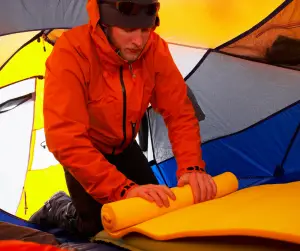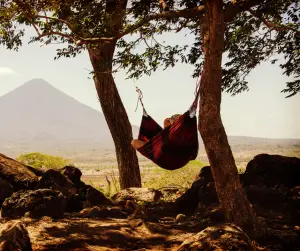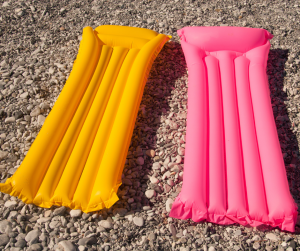A sleeping bag usually recalls fun-filled sleepovers at a friend’s house when you were a kid or times that you spent camping and experiencing outdoor adventures.
Not every occasion requires a sleeping bag to be used but remember that does not mean you should not be prepared for unforeseen circumstances.
But a proper survival sleeping bag can be expensive and is not a necessity for every outdoor excursion. It all depends on the environment you find yourself in.
Let us start with a few questions you need to ask yourself when it comes to sleeping in the outdoors.
SKIP AHEAD
What to Look for in a Sleeping Bag Alternative
Here are a few questions you should ask yourself when considering sleeping bag alternatives.
- What is my price range?
- What level of comfort do I desire?
- How long will the alternative be used?
- Is weight or space an issue?
- And most importantly, what level of protection do you need from the region’s weather?
Use the above questions to help determine what kind of gear you need when sleeping in the outdoors.
Top 10 Alternatives to Sleeping Bags
Emergency Bivvy
These are quite similar to emergency blankets, but there are a few differences that make them better.
Older style emergency mylar blankets were quite flimsy, tore easily and did not do the best job of keeping body heat in.
Modern bivvies are constructed of very thin material but they are much more durable than their counterparts. Additionally, a bivvy looks like a sleeping bag in that the side and bottom seams are sealed, which only leaves one opening at the top. This makes wrapping it around the body to retain body heat incredibly more efficient.
Pros
- Affordable
- Lightweight and compact
- Easy to use
- Can be clipped to the outside of a pack for transportation
- Water and wind-resistant
- Retains body heat efficiently
Cons
- Will not provide any cushioned comfort when sitting or lying inside of it
- These are marketed and designed to be used for survival situations, meaning they ideally should not be used repeatedly
- Can be easily punctured by rocks or sticks
Hammock
Simply, hammocks are a piece of material where two ends are strung up and attached to two anchor points, usually a set of tree trunks.
This bed design can be made up of a solid piece of material or “open” in the sense that it looks more like a large net. They can be traditional in material or insulated.
The real advantage of the hammock is that it gets a person off the ground that could be wet or cold, and by being elevated it provides a bit more protection against creepy crawlers or wildlife.
Pros
- Incredibly lightweight and compact
- Affordable
- Provides elevation off the ground
- A solid hammock can be used as an overhead tarp
- Does not require a perfect area to be set up
- Does not require a lot of brush and debris to be cleared away before setup
Cons
- May be uncomfortable to some
- Requires two sturdy anchor points
- Generally, are not well insulated or weatherproof
Cots
Usually, when one thinks of a cot, they think of the somewhat large beds that fold up and are used in hotels or possibly military-style ones.
Camp style beds or cots are like the above examples but are usually much smaller. They also may be designed to fit the curvature of the body or head more and will set up closer to the ground.
Pros
- Provides comfort that resembles sleeping in a regular bed
- Gets a person off the cold or wet ground
Cons
- These can be expensive
- Outdoor cots can be bulky and difficult to carry
Air Mattress
I do not know if you have ever slept on one of these, but an air mattress is pretty darn comfortable.
With the help of an air pump, these mattresses can be inflated and set up almost anywhere.
A manual air pump can be used although the process is easier and quicker when using a separate battery-powered pump. Higher-end models may have a built-in pump for convenience. Different sizes are available that sleeps one or more individuals.
Pros
- Wide price range allows for one to be purchased no matter the budget
- Easy to inflate and deflate
- Easy to transport when deflated
- Different sizes available
- Comfortable
Cons
- Using it depends on having a battery-powered or manual air pump
- The ground area needs to be clear of debris to prevent puncturing the mattress
- Does not provide any coverage above the body
Wool blanket
Having one or two wool blankets in a pack has been a great outdoor sleeping option for a long time.
This has to do with the fact that wool is an incredible insulator even when it becomes wet.
Even though this is just a blanket it can be used in a variety of ways such as a pillow, blanket, sleeping pad, blanket, impromptu poncho, or tarp covering. This is why having two of them can increase the number of ways in which they can be used.
Pros
- Fantastic insulator
- Can be used in several different manners
- Fairly lightweight
- Compact enough to carry on the outside of a pack
Cons
- Large wool blankets can be pricey
- When they become wet they are heavy
- Maybe itchy and uncomfortable to some people
Sleeping Pad
No matter what type of outdoor sleeping arrangement is chosen, a good sleeping pad seems to be a common theme among many outdoorsmen. This is because, during good weather conditions a good sleeping pad may be all one needs.

Providing comfort and insulation against a rocky, uneven cold ground is something that a good sleeping pad will do.
If you are looking into a sleeping pad do not skimp on the material. The thin, spongy foam may provide some insulation, but it will tear easily and will not do much in terms of comfort. Get something that is thick and durable.
Pros
- Lightweight and compact
- Affordable
- Comes in a variety of sizes
- Can be cut to custom sizes
- Provides great ground insulation
- Easy to set up and pack away
Cons
- While a pad does provide ground insulation it does not provide above-ground weatherproofing or warmth
Sleeping Bag Liner
This is one item some people might not be familiar with unless they use a sleeping bag frequently. A sleeping bag liner is a piece of material shaped like a sleeping bag that is inserted into the bag before a person gets in.
This liner primarily helps to keep the interior of a sleeping bag clean, but it can also help in repelling insects, providing warmth, and wicking away moisture.
Liners can be made from synthetics, silk, microfiber fleece, or cotton. If the weather is decent, one of these liners might be all you need in providing a little comfort against the environment.
Pros
- Overall lightweight and compact
- Affordable
- Easy to use
Cons
- By themselves, they do not work well in extreme temperatures
Clothes
This may not be for everyone but on several occasions, I have spent the night in the outdoors with nothing more than the clothes on my back.
However, this does require proper planning. Knowing the weather forecast, the right base layers, and the right outer layers needs to be known. With the correct preparation a person can survive the night with nothing more than the clothes on their backs.
Pros
- Affordable
- Does not require setting up any equipment
- Does not require carrying any extra gear
Cons
- Will not provide extra padding on the ground
- May not provide extra weatherproofing
Leaf Bed
A leaf bed uses a lot of dry vegetation, like leaves, as an insulating pad between a person and the ground. If several large trash bags are available, pack the vegetation into the bags, place them on the ground and use it as an impromptu sleeping pad.
Pros
- Incredibly affordable
- No “bed” to transport
- Easy to setup
Cons
- Will require some effort in collecting material
- May not be the most comfortable
Natural Structures
Of course, there could be that situation where you might find yourself without any of the above materials, though that would require a measure of unpreparedness that one should avoid.

However, accidents and emergencies do happen so what should you do if you find yourself in the middle of nowhere and lacking supplies?
Always use nature to the best of your ability!
Caves have been used as shelter by humans for a long time and will help to protect from the elements. Caution should be used because caves are often used by other critters and animals as well. Some small and some not so small.
Large, downed trees may provide an all-encompassing shelter or at least in part one that can give a little protection from the elements.
The last suggestion is to start digging. Animals do this all the time to create homes underground or to simply escape bad conditions. This may not be the best option in wet and rainy conditions, but you may be surprised at how much comfort a hole in the ground covered with some vegetation will give.
Pros
- Absolutely free!
- Can be used in any situation though most likely reserved for a survival scenario
- Do not have to carry any materials because the material from the environment is used
- May or may not require any setup
Cons
- Usually not comfortable
- Will not always keep a person ideally warm or dry
- Subject to sharing bed space with other critters
Verdict
It is the responsibility of every person who ventures out into nature to be as prepared as possible to avoid unnecessary situations that could put themselves as well as others in harm’s way.
The above article is meant to give ideas for sleeping accommodations that do not use a traditional sleeping bag in the outdoors. However, please use common sense when choosing a sleeping bag alternative and the environment in which you will be in.
The most simple and effective setup for sleeping in the outdoors would be a sleeping pad and some type of covering, both of which should keep a person warm and dry.
Thanks for reading and stay warm!
Are there any alternatives to sleeping bags that you use that did not make the list? Sound off in the comment section below and let us know!





